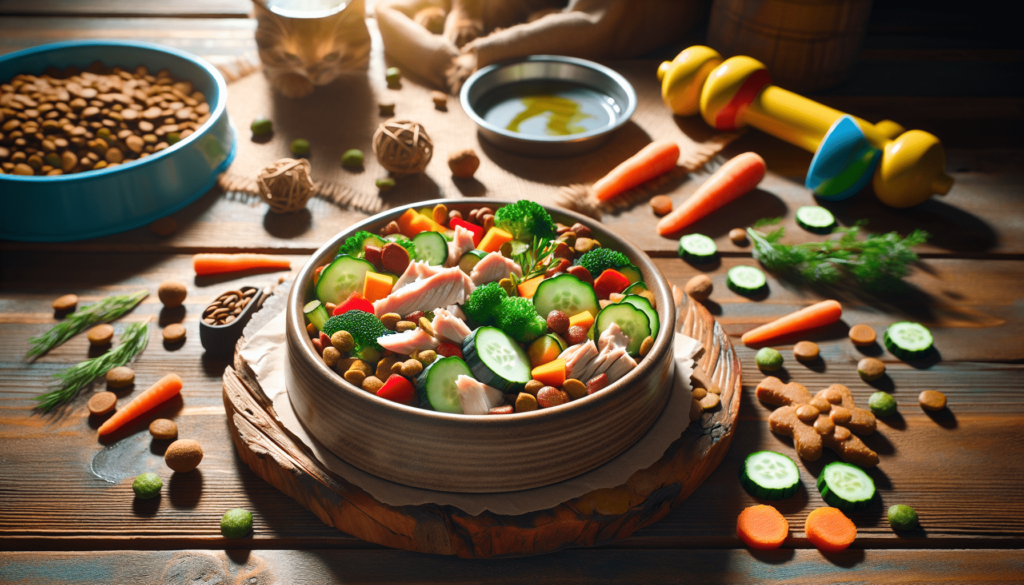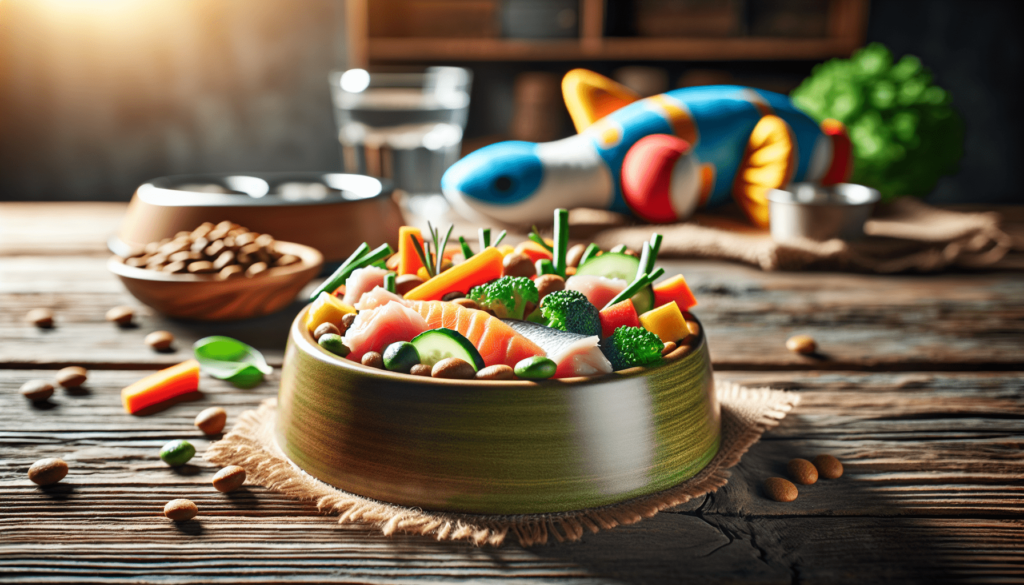What if you could boost your energy levels while ensuring your furry friend maintains a vibrant lifestyle?
As active dog owners, you know how important it is to keep up with your dog’s needs while also fueling your own activities.
Imagine a nutrition plan that aligns with your goals and enhances both yours and your dog’s vitality.

Why Choose Grain-Free Nutrition?
Embracing a grain-free diet isn’t just a trend; it’s a thoughtful approach to nutrition that many pet owners are adopting.
So, why should you consider this dietary shift for both you and your canine companion?
What are the Benefits of a Grain-Free Diet?
A grain-free diet can provide you and your dog with numerous health benefits.
It can potentially enhance energy levels, support weight management, and improve overall well-being.
Without the inclusion of grains, which can sometimes lead to allergies or sensitivities, both you and your pet might experience less inflammation and more energy in your daily endeavors.
How Does a Grain-Free Diet Support an Active Lifestyle?
When you’re active, your body craves certain nutrients to perform at its best.
Both you and your dog require a diet rich in protein and healthy fats, which are abundant in grain-free options.
This diet can fuel stamina, support muscle recovery, and keep energy levels high throughout your active days.
Are There Specific Ingredients to Look For?
When choosing grain-free foods, focus on high-quality protein sources such as chicken, beef, and fish.
Healthy fats from ingredients like sweet potatoes, peas, and various fruits and vegetables will also provide essential nutrients.
Understanding these components can help you make informed decisions about your meals and those of your furry friend.
How Can You Transition to a Grain-Free Diet Safely?
Transitioning to a new diet requires care and patience. It’s essential to gradually introduce grain-free foods to both your own and your dog’s menu.
Start by mixing your current foods with grain-free options to give your digestive systems time to adjust.
This process can prevent any digestive discomfort, making the transition smooth and enjoyable.
Crafting a Grain-Free Meal Plan for You and Your Dog
Creating a grain-free meal plan can be a fun and rewarding endeavor.
Both you and your dog can benefit from healthy, homemade meals that boost energy and odorlessly satisfy your hunger.
What Should Your Grain-Free Meal Plan Include?
Your meal plan should focus on lean proteins, a variety of fruits and vegetables, and healthy fats.
Choosing whole food sources ensures that both you and your dog are receiving essential nutrients.
You might also consider meal prepping to save time while ensuring that healthy options are already available when you need them.
How to Incorporate a Variety of Ingredients?
Variety is vital to prevent meal fatigue and ensure that both you and your dog receive a range of nutrients.
Incorporate a mix of meats, veggies, and healthy fats in various combinations.
This dynamic approach allows for creative meal preparation, which can be both fun and satisfying at the end of a busy day.
Can You Share Meals with Your Dog?
Absolutely! Many ingredients that are beneficial for your diet are also safe and nutritious for your dog.
You might consider sharing a simple grilled chicken dish or a veggie-packed stir-fry. Just be sure to avoid ingredients that are toxic to dogs, like onions and garlic.
How Can You Implement Meal Prepping?
Meal prepping can be a time-saver that maximizes efficiency in your busy life. Set aside a few hours each week to prepare bulk meals.
Store them in the fridge or freezer for quick access.
You’ll not only have nourishing meals ready for yourself but also wholesome food for your dog, all while saving time during the week.
Nutritional Supplements for Extra Support
Sometimes, food alone isn’t enough. For both you and your dog, nutritional supplements can offer additional support, particularly if you’re engaged in intense physical activities.
Which Supplements are Beneficial for Active Individuals?
Supplements like protein powder, omega-3 fatty acids, and multivitamins can be great additions for adults seeking to enhance their diets, especially if you’re regularly exercising.
These can support muscle recovery, improve heart health, and maintain overall well-being.
What About Nutritional Supplements for Dogs?
For dogs, supplements can also play an important role in maintaining their energy levels and overall health.
Consider omega-3 fatty acids for joint health, glucosamine for mobility, and probiotics for digestive health.
Consulting with your veterinarian can help you choose the right options tailored to your pup’s specific needs.
How Do You Choose Quality Supplements?
Quality matters when selecting supplements. Look for those that are tested for purity and potency.
Research reputable brands, read labels carefully, and consult professionals. This diligence ensures both you and your dog receive the best support possible.
Are Natural Supplements Available?
Yes, many natural supplements are available for both you and your dog. They usually involve herbal ingredients or food-based components.
These can offer holistic benefits without synthetic additives, enhancing your grain-free lifestyle.
Cooking Grain-Free Recipes Together
Cooking delicious meals together can strengthen the bond between you and your dog while ensuring both of you enjoy nutritious feasts.
What Are Some Simple Grain-Free Recipes?
There are countless grain-free recipes you might enjoy making. For you, consider a chicken and vegetable stir-fry cooked in coconut oil.
For your dog, a simple homemade beef stew using stewing meat and diced veggies could be a treat. Customizing meals to suit both your palates can be a delightful practice.
How Can You Ensure the Meals are Balanced?
Making sure both your meals and your dog’s meals are balanced is crucial.
Incorporate a variety of proteins, healthy fats, and multiple veggies. Aim for color and diversity on your plate – the more vibrant the mix, the better it is for nutrition.
What Should You Avoid When Cooking for Your Pet?
While cooking for your dog can be rewarding, you must avoid certain ingredients, such as chocolate, grapes, raisins, onions, garlic, and avocados.
Keeping these away from your cooking ensures the safety and health of your furry friend.
How Can You Experiment with Flavors?
Exploring different herbs and spices can make meals exciting! While some herbs are safe for dogs, it’s important to prioritize their health.
You might use rosemary or parsley for your dishes while ensuring that any flavoring you add is safe for your dog.

Understanding the Myths Surrounding Grain-Free Diets
With any nutrition plan, myths often abound. Separating fact from fiction can help you make informed choices.
Is Grain-Free Only for Dogs with Allergies?
While grain-free diets can indeed benefit dogs with grain sensitivities, it is not exclusive to them.
Many healthy dogs do well on grain-free diets, which can provide increased energy and better overall health.
Is Grain-Free Diet Really Better?
The effectiveness of a grain-free diet largely depends on individual needs.
For some, eliminating grains can greatly improve health; for others with no sensitivities, a balanced diet that includes grains may be perfectly fine.
Understanding your unique needs is key.
Can Grain-Free Meals Be Expensive?
A common misconception is that grain-free diets are significantly more expensive.
While some grain-free options might cost a bit more, you can often find budget-friendly recipes using whole ingredients.
Cooking at home can also save you considerable money in the long run.
Are Grain-Free Diets Sustainable?
Sustainability varies by individual diet and lifestyle choices.
You can adopt a grain-free approach while also considering local, seasonal ingredients that minimize your environmental footprint.
Focus on sustainable sourcing for proteins and produce for a thoughtful meal plan.
Staying Energized Throughout Your Day
With an active lifestyle, sustaining your energy is essential. Adopting a grain-free diet can support those energy levels effectively.
How Can You Sustain Energy for Your Activities?
Building meals that are high in protein and healthy fats will provide lasting energy.
Combine these components well, and you will maintain your energy throughout your busy day, whether you are walking, running, or hiking with your furry friend.
What Snacks Can Help with Energy Levels?
Snacks are important to keep you energized.
Consider protein-packed options like nut butter with fruit, kale chips, or even veggie sticks with hummus.
Your dog can enjoy healthy treats made from freeze-dried meat or homemade fish-based biscuits.
How Can Hydration Play a Role in Energy?
Don’t overlook the significance of hydration. Staying well-hydrated boosts energy levels for both you and your dog.
Always carry water, whether you’re out for a quick walk or an extended outdoor adventure.
How to Identify Signs of Energy Depletion?
Listening to your body and observing your dog’s behavior can signal when it’s time to recharge.
Signs might include increased fatigue, irritability, or decreased interest in physical activity.
Recognizing these signs early can help you adjust your nutrition accordingly.
Frequently Asked Questions (FAQs)
- What are some common grain-free ingredients? Consider proteins like chicken, beef, fish, and plant-based options like peas and lentils.
- Can I transition my dog to a grain-free diet right away? It’s best to gradually introduce new foods to avoid digestive upset.
- Is a grain-free diet suitable for all dog breeds? Most breeds can thrive on a grain-free diet, but consult with a vet for breed-specific advice.
- What are signs that a grain-free diet is working? Look for improvements in energy levels, coat quality, and overall health.
- How can I get my dog to try new foods? Introduce new flavors gradually and mix them into their usual food.
- Are there any grains that are safe for dogs? Some dogs do fine with easily digestible grains like oatmeal.
- Can I feed my dog homemade meals long-term? Yes, but ensure that meals are balanced and meet all dietary needs.
- What should I do if my dog has an adverse reaction to grain-free food? Consult a veterinarian immediately to identify the cause and revise the diet.
- How often should I change up the protein sources in my dog’s diet? You can rotate protein sources every few weeks to maintain variety.
- Are there drawbacks to grain-free diets for dogs? Some dogs may not have sensitivities to grains, and nutritional needs can vary widely.
Conclusion
Navigating a grain-free diet for yourself and your furry companion is a fulfilling journey.
With the right knowledge, practical meal-planning strategies, and a variety of ingredients at your disposal, you can design an eating plan that fuels active lifestyles and enhances overall well-being.
Remember, nutrition is a personal venture, and listening to your body (or your dog) is essential.
Consider taking actionable steps today by experimenting with one new grain-free recipe for yourself and your dog.
You might just discover a delightful meal that energizes both of you!
It’s time to enjoy the benefits of grain-free nutrition together, embracing a vibrant and active life filled with energy and joy.
